“Jagannatha Temple” has been added to your cart.
View cart
-
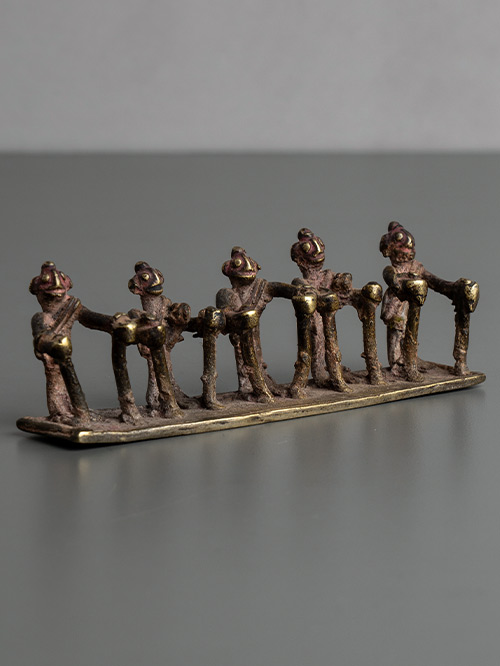
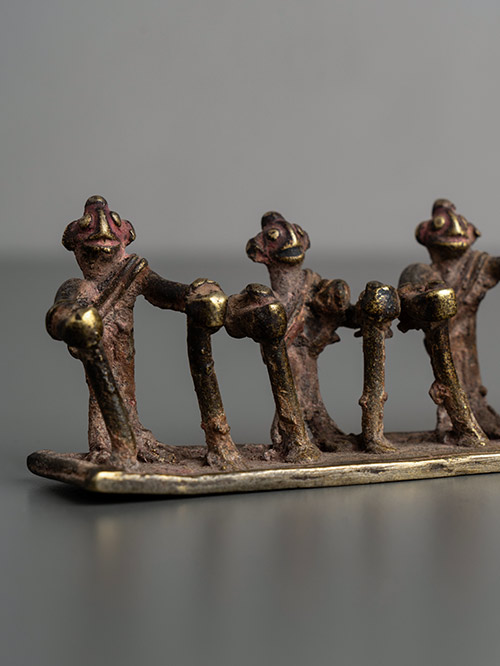
Maharashtra
Brass alloy
This folk bronze depicts a group of munjas (spirits) represented as five men, each holding a pair of sticks and adorned with a yajnopavita (sacred thread). These figures symbolise young men who tragically passed away at the age when they had just begun their studies. To honour their memory and appease their spirits, such figurines are placed on household altars. Through ritual ablution and ceremonies, these ghosts are believed to be transformed into pitra (protective ancestors) who safeguard the family.
Size (cms): 5(H) x 14.5(W) x 3(D)
Size (inches): 2(H) x 5.5(W) x 1(D)
-
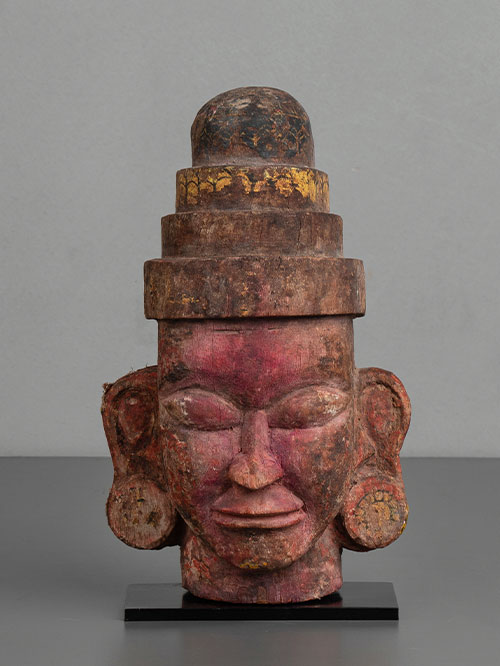
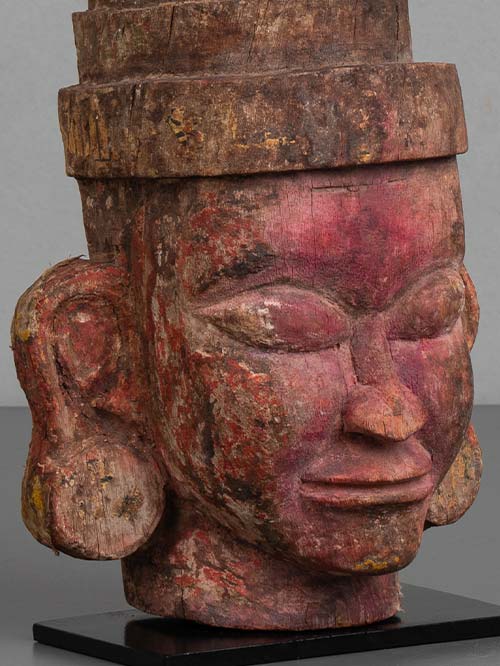
Karnataka
Wood
A charming folk wooden carved head of a male attendant/guardian figure wearing a tiered crown and large ornamental earrings. Such figures were placed in folk temples in Karnataka and usually painted and clothed.
Attendant figures called Dwarapalas or ‘door guardians’ are placed at the entrance of every temple, shrine or sacred precinct. Two or four-handed, they sometimes carry in their hands the emblem of the deity enshrined in the sanctuary. Their countenance may sometimes be fierce and occasionally fangs protrude from their mouths. Temples dedicated to goddesses have female guardians – the Dwarapalikas.
Size (cms): 25(H) x 15(W) x 10(D)
Size (inches): 10(H) x 6(W) x 4(D)
-
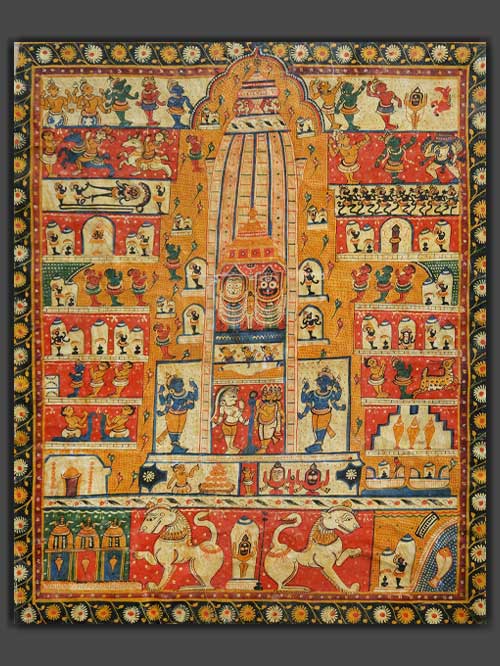
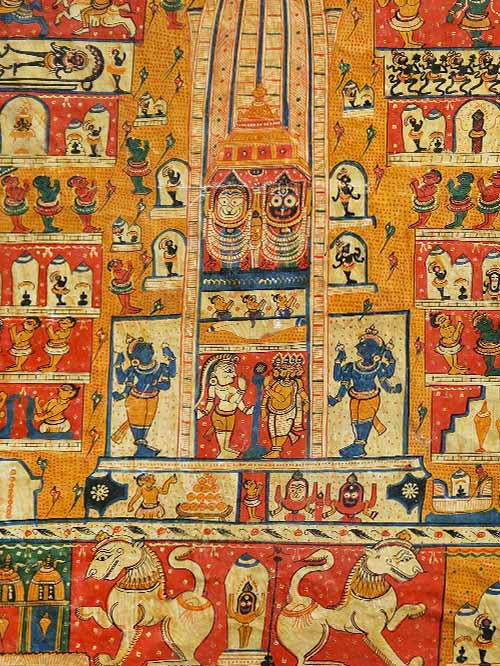
Orissa, Puri district
Opaque water-based pigments and lacquer on cotton cloth
This exceptional, large pilgrimage pattachitra depicts the Puri temple complex, sacred sites in the temple town and mythological themes and scenes. The Jagannatha temple complex dominates the diagram, showing the central shrine midway up a slender shikhara or tower. The two male figures, Jagannatha and Balabhadra are shown dancing with raised yellow wing-like ‘arms’ and the female Subhadra standing between them. Within the temple complex are a variety of small shrines. A pair of prancing leogryphs form the Lions Gate at the bottom of the temple structure. The other sacred sites and shrines in Puri which are divided into registers, are illustrated on either side of the temple compound. These include a temple dedicated to Shiva and Brahma. Also illustrated are many mythological themes related to the god Vishnu, including his ten incarnations (dashavatara) arranged in a line above the sanctuary. Shown in a panel at the top left are Jagannatha and Balabhadra on horseback being given curds by the milkmaid Manika as they ride to the aid of the Raja of Puri. On the right is the hero Rama, another avatar of Vishnu, and his brother Lakshmana defeating the demon Ravana.
Puri painting, one of India’s oldest popular iconic traditions, is associated with the regional following of Jagannatha, a manifestation of the god Vishnu, and with the ancient pilgrimage centre of Puri in Orissa on the eastern coast of India on the Bay of Bengal, where the cult took hold. The cult evolved from a synthesis of local tribal gods and Hindu deities worshipped today as Jagannatha, Balabhadra, and Subhadra. Jagannatha, literally meaning “Lord of the World” is a form of Krishna, the eighth incarnation of Vishnu. Balabhadra is Balarama, the seventh incarnation of Vishnu and Subhadra is Krishna’s sister. The painting tradition evolved to serve the cult, with painters playing an important role by performing certain tasks at particular times in the elaborate cycle of rituals.
Size (cms): 54.6(H) x 43.2(W)
Size (inches): 21.5(H) x 17(W)
-
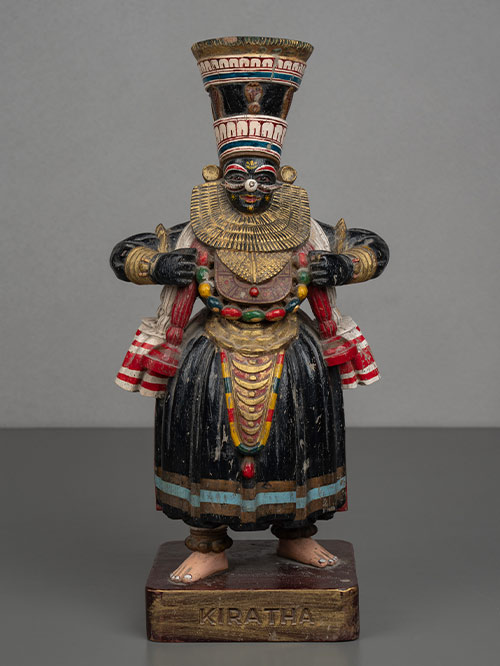

RESERVED
Kerala
Wood, extensively polychromed
An exceptional carved figure of a Kathakali dancer representing Kiratha (Shiva), with finely detailed headgear and costume.
Kiratham Kathakali is a powerful Kathakali performance based on Kirātārjunīyam, depicting Arjuna’s encounter with Lord Shiva, who appears as a hunter (Kiratha) to test his devotion. A dispute over a slain boar leads to a fierce battle, where Arjuna is ultimately defeated and realizes Shiva’s true identity. Pleased with his perseverance, Shiva grants him the divine Pashupatastra (weapon). Known for its earthy Malayalam verses, Kiratham appeals to both connoisseurs and laymen alike. It is deeply devotional, frequently performed in Shiva temples, and is typically the final story in an all-night Kathakali performance, making it a climactic and spiritually significant act.
Kathakali, a dance drama unique to Kerala, emerged in the 17th century, evolving from ritual theatre traditions and Kutiyattam Sanskrit drama. Rooted in Malayalam adaptations of the Ramayana and Mahabharata, it was traditionally performed in temple courtyards or patrons’ homes from nightfall to sunrise, often during harvest festivals or as summer entertainment. Accompanied by temple music with a unique singing style, bronze gongs, cymbals, and drums enhance the performance’s intensity. Kathakali is distinguished by elaborate costumes, ornate headgear identifying heroes and demons, stylised movements, and striking makeup in green, red, yellow, black, and white.
Size (cms): 28(H) x 14(W) x 10(D)
Size (inches): 11(H) x 5.5(W) x 4(D)









